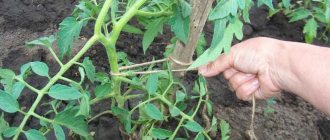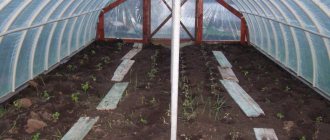Tall varieties of tomatoes are often grown in greenhouses; they bring a large harvest and grow well in closed ground. Such tomatoes require a mandatory garter - under the weight of the fruit, not only the branches, but also the stem itself can break off. When growing this crop, beginning gardeners often make mistakes by tying the stems incorrectly and with the wrong material, which greatly affects the quality and quantity of the harvest. Let's look at the most common options for attaching stems.
Why do you need a tomato garter?
With rare exceptions, all varieties of tomatoes need the garter procedure. Most often I like tall plants. They can be grown both in a greenhouse and in a garden bed. When growing outside, this procedure is required.
Here are some important reasons why you need to ensure an optimal level of safety for tomatoes:
- tall tomatoes may break under the weight of the fruit;
- gartering tomatoes achieves an important point: the fruits will always be above the soil level. Diseases and pests of fruit plants will be less dangerous for the plant;
- in this form it is much easier to take stepson. Stepchildren take a lot of strength and nutrients from a tomato. The fruits on them rarely have time to ripen. Therefore, it is better not to leave more than 1-2 stepsons.
- It will also be easier to care for: apply fertilizer right to the roots and water.
Autumn and spring preparation of the greenhouse
This stage is especially important. It all starts with cleaning the room. It should be carried out at the end of each season.
- The remaining fruits and tops need to be removed from the greenhouse. This reduces the risk of fungal diseases. Pathogens can be located in different parts of the soil, in its upper layers.
- After removing the residue, wash the greenhouse with soapy water.
- The next step should be stripping, priming and painting the damaged areas. This is necessary to prevent corrosion and improve the appearance of the structure.
- Wooden parts are treated with antibacterial and antifungal agents. Copper sulfate is distinguished among them. Mixtures can be purchased at a specialized store or made with your own hands. After using preparations containing sulfur, the metal frame may acquire a darker color. This is due to the properties of this substance. Therefore, you will have to refuse products with such a composition. In the current circumstances, the structure must be covered with a solution of chlorinated lime. The composition of water and the active ingredient must be infused for 4-5 hours. Processing of the greenhouse should be carried out wearing gloves and a respirator.
Before you start digging, you must:
- remove the top layer of soil;
- disinfect the soil with a solution of copper sulfate;
- apply mineral and organic fertilizers.
A nutrient mass prepared from organic substances is applied to a depth of 2-3 cm 14 days before planting tomatoes in the greenhouse.
When preparing the soil, natural green fertilizers are often used. The richest sources of green manure include beans, phacelia, lupine, rapeseed, sweet clover, oats, mustard, alfalfa and barley.
By taking land from areas where these crops were previously grown, the summer resident will be able to get a good harvest. Cleaning is carried out in the autumn. The remaining activities can be completed in the spring.
2 weeks before planting the seedlings, the soil must be loosened and the weeds removed. This will ensure good aeration. If the soil is not fertile enough, it is fertilized with organic matter. 2-3 kg of organic fertilizer is required per 1 m². The beds are formed observing the following parameters:
- height – 40 cm;
- width – 90 cm.
There should be at least 60 cm between trenches or holes. Tomatoes need good lighting, so the greenhouse should be located in an open place, from east to west. Even slight shading can reduce yields.
The ridges are formed 10 days before planting the seedlings. To insulate the selected area, straw, sawdust or pine needles are placed under the soil. The layer thickness should be at least 10 cm. Then compost and soil are laid. In winter, the soil should be covered with snow. He will prevent it from freezing. An additional bonus is soil moisture in the spring.
Garter tomato during cultivation in a greenhouse
It is not at all difficult to fix it strictly vertically if you use the greenhouse growing method. You will need supports of the required height and suitable material for dressing. Old knee socks, nylon tights, and narrow strips of fabric will do. You can just buy plastic clips.
Never perform this procedure using materials that are not suitable for this purpose. It is important to tie up the tomatoes correctly.
Garter tomato in outdoor conditions
When growing tomatoes outdoors, you should pay more attention to the garter procedure. Heavy rain or wind can break not only the grooves, but ruin the entire bush. That’s why it’s so important to properly tie up tomatoes outside.
Tomato garter stakes
Why is it so important to decide for yourself the question: “how to tie up tomatoes”? The answer lies on the surface. Rain and wind can pose a significant threat to your tomatoes. Requirements for supports will have to be tightened.
If you prefer medium and low varieties, then the pegs themselves should be 30 cm higher than the plants. For tall ones, this figure is already much higher: from 2 to 2.5 m. They retreat from the trunk at a distance of about 15 centimeters. This is important so that you do not damage the root system. Do not tighten the material for gartering tomatoes too tightly, as this may damage the stems of the plant.
Tomato cages refer to small structures. They will reliably protect and will not allow the bush to break or otherwise be damaged.
Materials for tying
- Wooden beams or metal rods,
- twine (twine), long strips of cotton fabric,
- garter tool (tapener).
For these purposes, you can tear an old sheet or nylon tights that are no longer in use into strips of 5-6 cm. Nylon tights as a garter material are soft, elastic, durable.
If the garters have been preserved from last year, they can be reused after sanitizing.
Boiling and disinfection will protect the bushes from diseases.
The main stem is tied with a soft strip of fabric or pieces of tights; the branches can be tied with ordinary twine, folded in half or three.
A special tool called a tapener will help you perform the operation super quickly and without knots. They weigh little and are easy to work with.
This device is specially designed for tying climbing and creeping plants: grapes, tomatoes, cucumbers, raspberry bushes, currants, roses. He secures the bush with an elastic band and secures it with a metal bracket. In the photo below you can see an example of his work:
Caps for tomatoes
Extremely convenient and unusual designs for gartering tomatoes in open ground. They are suitable even for very tall varieties of tomatoes.
You need to build a pyramid from any available means. Wire, stakes with a transverse ligament, willow twigs, and vines are suitable. The distance between structures should not be less than 1 meter. One cap will provide comfort outdoors for several plants at once.
On hook
It is very important to tie a tomato garter in open ground. Place pegs on the sides of the bed for this important procedure. Between them, pass the cable between two adjacent sticks. Then you need to attach a fishing line with loops located at different heights. The optimal distance between stakes is 20 to 25 cm.
Hooks must be inserted into the loops, always made of thick wire. They should be S-shaped. It is the hooks that tension the line itself. A branch or bunch of tomatoes must be placed under an elastic ring. The hook is threaded through it. The fishing line is tied to a stake in front of each plant. When the plant gets taller, simply move the hook to a higher loop.
Clamp for supporting grafted branches from DRTOOLS (2 -4.5 cm, 50 pcs)
Price: from 106.94 rub. (check price and discount)
Seller's reliability: excellent!
Delivery within Russia: free!
Be sure to order on the Aliexpress website with free delivery throughout Russia.
Good quality, for branches up to 5 mm in diameter. Great for orchids. I recommend! Delivery 25 days to Kyiv.
Crazy Pie
Cute little clips for thin branches. Thanks to the seller!
Alsantrius
Small ones. Durable. For grafting cucumbers, melons, watermelons, etc. this is what you need.
Crazy
View on AliExpress:
Unusual ways to support tomatoes
Non-standard methods are associated in the configuration of structures of unusual supports. I suggest you get to know them in a little more detail.
Well suited for these purposes:
- thorny blackberry branches;
- hazel;
- willow twigs;
- trimmed branches from seedlings;
- various vines, vines or regular twine.
Fruit support clamp from SANGEMAMA (4 cm, 100 pcs)
Price: from 180.43 rub. (check price and discount)
Seller's reliability: excellent!
Delivery within Russia: free!
Be sure to order on the Aliexpress website with free delivery throughout Russia.
Everything is simply good to the point of banality!
Dweller of the Internet
Thank you very much, very fast delivery, good seller, I’ve been using these holders for two years now.
Zheka
Interesting thing. I hope this helps - the holder has some flexibility (which is good). Recommendation for users: hang this case while the tomato brush is still young and thin to prevent it from being damaged.
artman
View on AliExpress:
Lattice for garter
You will need a couple of buried grates. They should be tilted in different directions from each other. The tomatoes growing between them will themselves support the cunning structure.
Select the height of each trellis taking into account the maximum height of the tomato bushes. You won’t have to tie up a single tomato bush. The tomatoes themselves will choose a convenient place on the trellis holder.
How to tie correctly, diagram
The correct garter scheme is selected depending on the characteristics of not only the tomato being directly grown, but also on the characteristics of the greenhouse.
Although the material of the greenhouse itself does not matter: in a polycarbonate greenhouse, tying is carried out in exactly the same way as in a film or glass greenhouse.
- Proper tying is tying at the seedling stage. A later procedure may injure the growing bush.
- The second mandatory condition is constant monitoring of growth in order to have time to carry out secondary tying before the stem can lie on the ground.
Bushes are tied up either individually (pegs) or en masse (all other methods).
Garter method using stakes
The most common method used is an individual garter using stakes, when they are driven into the ground next to each plant. The height of each peg should be equal to the height of the tomato bush plus 30 cm (this is the depth of immersion in the ground).
Important! It is necessary to take into account the height of the adult plant, not the stem of the seedling! As the tomato grows, you will not need to change the garter stakes. Therefore, immediately see what the maximum height of a given variety or hybrid is, and calculate from this.
You can use scraps of reinforcement, metal rods, plastic pipes and others as supports.
When the peg is driven in, the plant growing nearby is loosely tied with fabric, the garter is crossed in a figure eight and tied to the peg. Brushes are also attached. You don't need to tie it too tightly.
This method has two significant drawbacks when used for indeterminate tomatoes.
- A growing crop (and it can reach 2 m in height) must be constantly tied up, moving the garters up along the support.
- And in the event of a bountiful harvest, the plant may collapse along with its supports and garters, unable to withstand the weight of the fruit.
Trellis tying method
The trellis method is more reliable - but also more complex. To form trellises, you must first form rows of supports along the beds, driving in long stakes and pulling several wires or strings with a height difference of 30-40 cm.
As the tomato bush grows, its stems and branches are first laid behind a stretched wire on one side, then on the other, so that such a braid holds the growing tomato bush in an upright position. Brushes with pouring tomatoes also need to be tied up or hung using special hooks.
Gardeners note the advantage of this method is that there is no need to plant bushes into one or two stems; you can leave a larger number and thus increase the yield.
For linear trellis garter:
- The same pegs are driven in, only the horizontal wire is stretched alone - along the very top.
- “Leashes” are tied on it above each plant, which are attached around the stem in its lower part.
- Next, the growing stem is simply wrapped around the leash as it grows.
Shield garter
Installed lattice panels (grids) are a more expensive method than trellises and especially pegs.
The method is convenient in that plants planted along such nets can be tied to different parts of the boards as they grow using twine or other materials, and both stems and brushes are tied.
The lattice structures themselves are installed by tying them to a row of pegs with wire. Such meshes can be either metal or wire.
The disadvantage of shield garter is that when growing tomatoes on an industrial scale, the installation of such structures greatly increases the cost of the final product.
How to tie up tomatoes. “Free loop” method - video
other methods
The frames are a lattice structure surrounding the perimeter of each tomato bush. The plant does not need to be tied to it; the stem will find support from all sides.
The disadvantage of such support is the difficulty in harvesting.
Methods such as portable structures (trellises) are also used.











